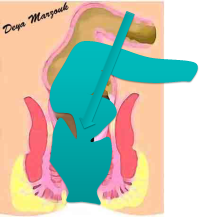
Obstruted Defaecation Web

| Imaging & Physiology |
|
Anorectal physiology testing was instrumental in advancing our knowledge of functional bowel problems. It remains important in completing the anatomical & physiological profile of patients with ODS & incontinence. It complements, but does not replace clinical judgment. It is important to get these tests done in an established lab, since long experience in performing these tests increases their reliability. Nevertheless, these results should always be interpreted with caution by experienced clinicians. An important example of this statment is in theinterpretation of the degree of internal rectal intussusception & its significance. Proctography is much less reliable if the patient fails to evacuate fully [i.e. a type 3 IRI may be interpreted as normal or type 1 IRI]. We send our patients to the excellent unit at the Royal London Hospital. These tests very briefly involve: Measurment of anal canal length & pressures during resting & squeezing, ultrasound of the integrity of anal sphincters and assessment of the nerve supply to the pelvic floor & sphincter muscules. It also involves measurment of rectal volumes, rectal sensation, rectal evacuation & any anatomical abnormalities or prolapse of the rectal wall as well measuring the speed of transit along the colon. Having contrast in the small bowel, sigmoid & bladder during proctography makes this examination more useful. Alternatively MRI proctography is increasingly useful in evaluation of certain subsets of patients such as those with ODS secondary to enterocoele.
|